🎵🎵 Let’s start at the very beginning 🎵🎵 a very good place to start 🎵🎵

Just like Maria in the Sound of Music (if you are too young to know what this is, keep it to yourself), we are going to start off this journey strong. Which means we are going to get you to understand the basics of the structure and function of the heart.
Don’t worry, this isn’t going to be an anatomy lecture….but realistically, unless you start understanding the basics of blood flow and pressures, you won’t get far in cardiology. I don’t make the rules 🤷♀️🤷♀️🤷♀️.
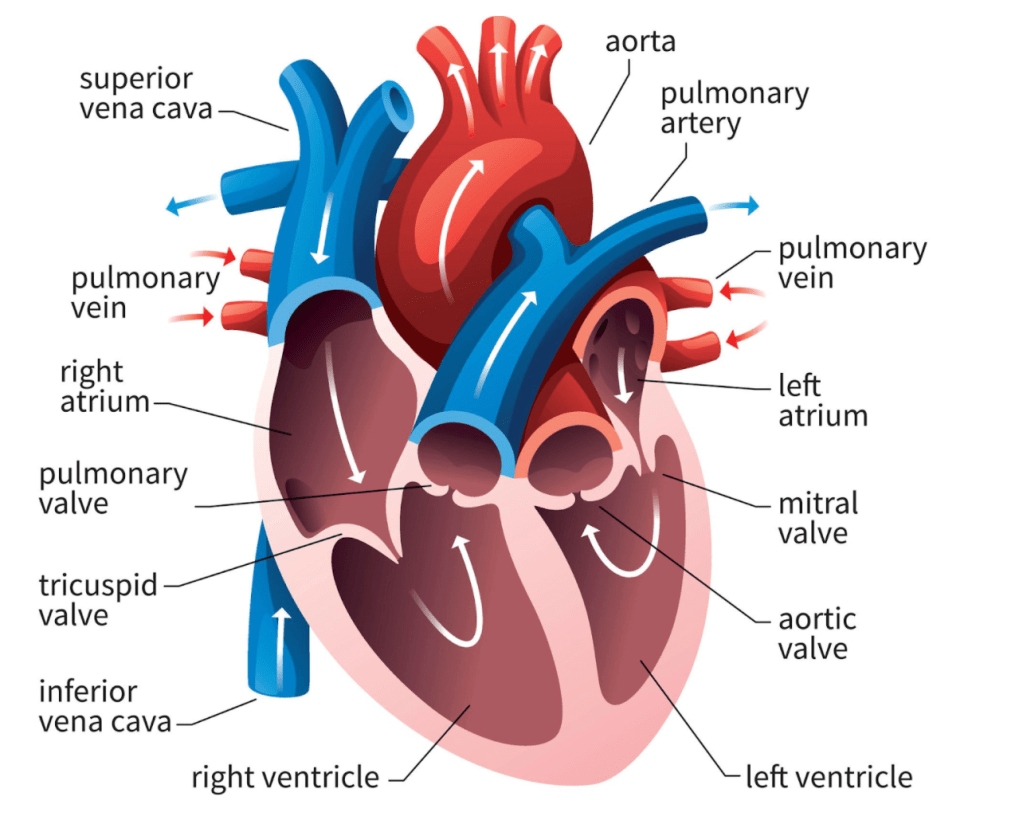
Always remember that since you are looking at a heart diagram head on, that everything is reversed (e.g. the right side of the image represents the left side of the heart).
There she is. The basis of everything we’re going to talk about….let’s get into it!
Your heart is at the center of your circulatory system. Your heart has two main purposes: to help oxygenate blood by sending blood through your pulmonary system and to propel that blood to the rest of the body. All the tissues and organs of your body need oxygen to survive, and your heart helps to make this happen. Which is why it’s definitely the most important organ of the body (no, I’m not biased I swear *flashback to residency when my ID colleagues once called the heart the antibiotic pumping machine of the body*).
First let’s summarize things quickly, and then we can get into some more detail.
Let’s start with your veins.
Your veins generally contain deoxygenated blood – this blood has already done its job and delivered its oxygen to your body’s tissues/organs.
Your veins connect to the right side of your heart. Through its pumping power, your heart is able to take that blood to your lungs, where that blood picks up oxygen (and gets rid of its waste).
This oxygenated blood then goes from the lungs back to the heart (now on the left side) and your heart propels this oxygenated blood out to your body through vessels called arteries.
Your arteries branch off throughout your body, and branching off of these arteries are smaller arteries known as arterioles. These arterioles then form capillary beds where capillaries allow for oxygen delivery to the tissues. Capillaries are very very tiny blood vessels – so small that a single red blood cell can barely fit through them. The capillaries serve as the intermediate (or middle man) between the arteries and the veins. Check out the diagram below.
These capillaries then carry the deoxygenated blood into small veins known as venules which then eventually collect into the larger veins which eventually meet at the heart to get oxygen again and – the whole cycle repeats.
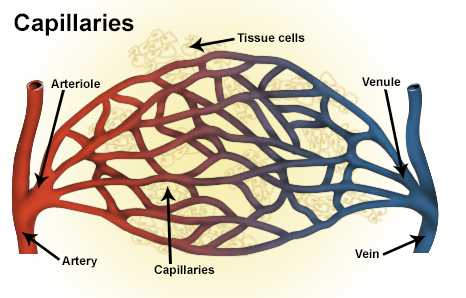
BTW, there’s also a physiologic difference between arteries and veins. This will come into play when we will eventually discuss calcium channel blockers.

As the vessels closest to your left ventricle – your arteries have to contend with high pressures from the blood being forced through them. They pulse with each heartbeat (which is why your pulse is taken from arteries). In order to handle these high pressures, your arteries are thick and contain a lot more smooth muscle than veins.
Your veins are way thinner and see less pressure – but to combat the force of gravity as they climb back up to the heart, they have valves located throughout them to prevent the backflow of blood.
That’s the process in a nutshell. But let’s get into some specifics now.
Deoxygenated blood from your capillaries flow into the venules and enter into venous circulation. Your veins all meet up in the vena cavae. The vena cavae is the collective term for the main venous great vessels that are responsible for returning deoxygenated blood to the heart.
There are two of these vessels – the superior vena cava (AKA the SVC) and the inferior vena cava (AKA the IVC). These vessels collect the deoxygenated blood from different parts of the body.
The IVC is formed in the abdomen by the coming together of the two common iliac veins and brings about ~3/4 of your total venous return to your heart. The SVC is the coming together of the left and right brachiocephalic veins and brings about ~1/4 of venous return to the heart.
Pro tip: When try to remember the vena cavae as the supplier of venous return, think V is for vein, therefore the vena cavae serve as the big vessels that return blood back to the heart.
OK so, the vena cavae bring blood back to the heart – more specifically into the right atrium. Check out the diagram below.
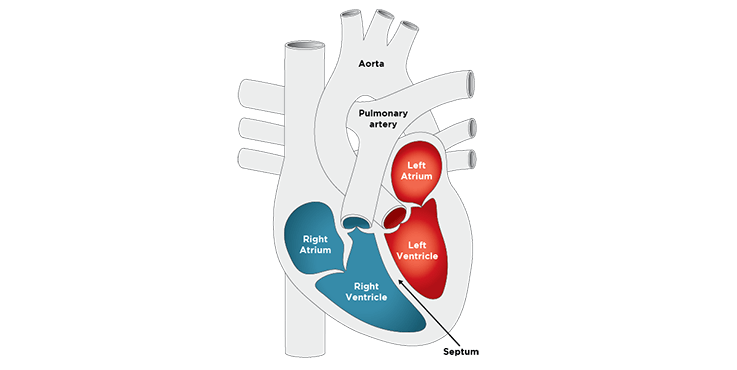
Now that our blood has entered our heart, let’s talk a little bit about the heart structure. The heart is made up of four main chambers – two atria (the upper chambers) and two ventricles (the lower chambers).
The atria are fairly thin-walled chambers. Your atria just aren’t built to withstand super high pressures and they naturally have a much lower contracting power than the ventricles – afterall, the main goal of the atria are only to get blood from one chamber to the next (from the atria to the ventricles).
The ventricles are a different story. Think of them as the meatheads of the heart. You know those kids in gym class in high school who were naturally athletic and had muscle? Yep, that’s your ventricles. Thick walled and powerful, these lower chambers are meant to generate high pressures to push and propel blood through vessels and organs.
Back to the flow of blood. To remind you, we are deoxygenated blood that just entered the right atria from the vena cava. Blood is next going to flow through the tricuspid valve and enter the right ventricle. That right ventricle is going to generate high pressures when it contracts and force blood through the pulmonary artery and into the lungs.
Protip: when remembering vasculature, remember that “A is for away” – in other words arteries always leave the heart.
Because blood is leaving the heart to go to the lungs, it leaves via the pulmonary artery (NOT the pulmonary vein – remember – A is for away!). This makes the pulmonary artery the exception to the “rule” that arteries contain oxygenated blood.
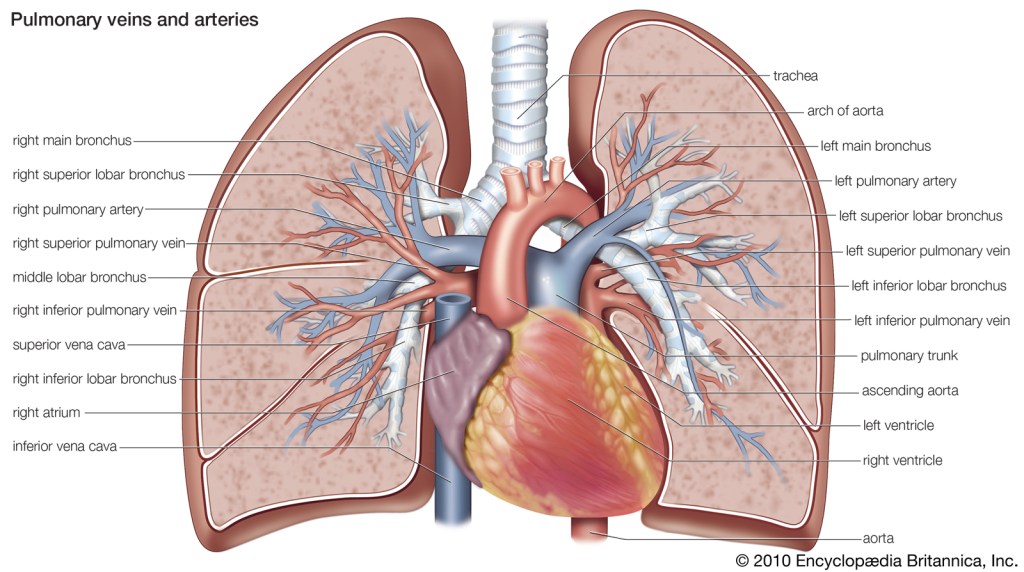
Now let’s take a 10,000 ft view. The pulmonary artery (or pulmonary trunk) branches off into the left and right pulmonary arteries. It’s here where the vessels are going to branch off and eventually turn into teeny tiny lil capillaries that wrap around your little alveoli in your lungs and undergo some great gas exchange.
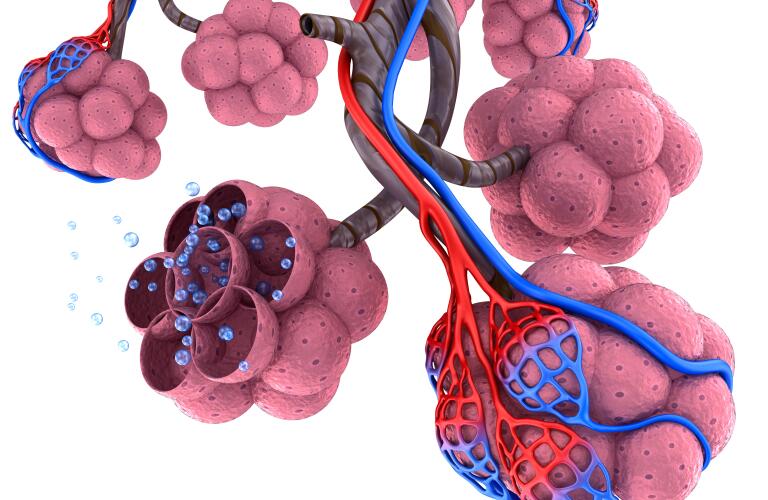
These lil capillaries now have oxygenated blood in them for the first time in this cycle. These capillaries are going to get larger and become pulmonary veins as they head back to the heart and enter the left atrium (again, just like the pulmonary artery, the pulmonary vein is the exception to the rule that veins contain deoxygenated blood). Blood will then leave the left atrium, pass through the mitral (aka bicuspid) valve, and end up in the left ventricle.
Now, the left ventricle is kinda a big deal. If the right ventricle is beefed-up Chris Pratt, the left ventricle is more Dwayne the Rock Johnson status.

The left ventricle is known as the workhorse of the heart. He’s the guy that really keeps the whole show running. By far the most muscle chamber of our heart, the left ventricle is responsible for squeezing – hard – and generating those high contraction pressures to effectively push blood out of your heart and serves as the force to propel your blood to the rest of your body. Like I said, he’s kinda a big deal. Blood is pushed out of your left ventricle, passes through your aortic valve and enters the aorta.
Just like the vena cavae were the biggest veins in your body, the aorta is the biggest artery in the body. Remember that arteries take blood away from the heart, and so the BIG artery in your body is known as the aorta (a is for away!).
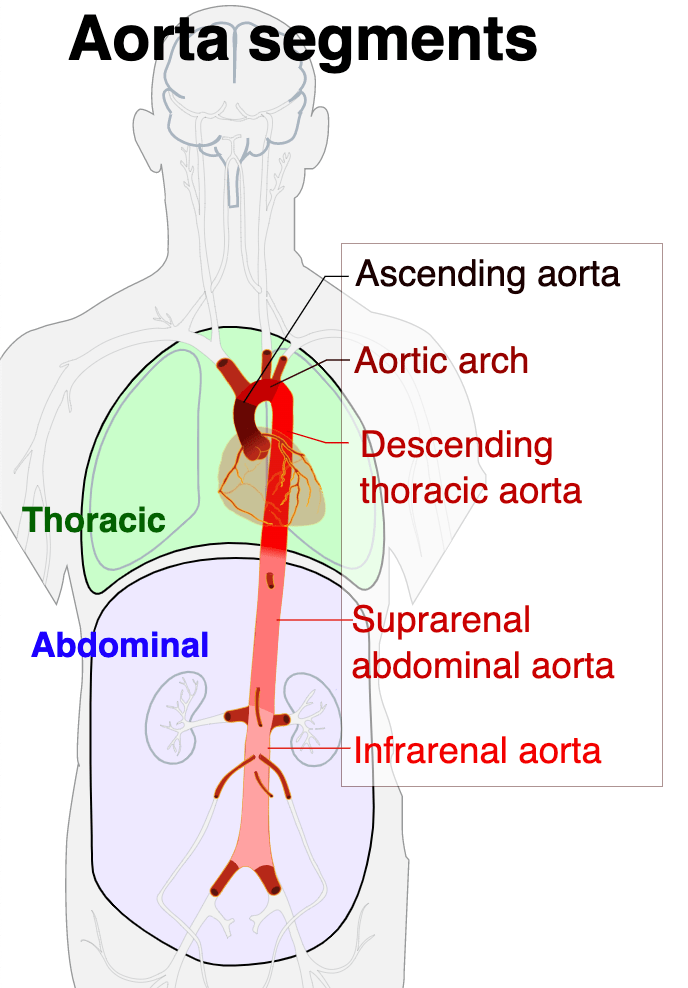
Your aorta is the main artery that carries blood away from your heart and to the rest of your body. It spans all the way down your trunk. I like to think of it as your blood’s major highway and from there, blood exits to feed various organs and tissues. These organs and tissues eventually enter venous circulation, end up at the vena cavae….and – you guessed it- the whole cycle restarts.
Just like every other organ in your body, your heart needs its own blood supply to function.
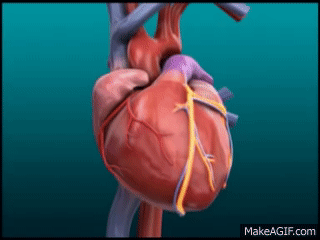
Early on in the aorta (we call this section the ascending aorta since it heads upwards), vessels known as the coronary arteries branch off of the oxygen-rich aorta and feed the heart with its own supply of oxygenated blood.

Given that these arteries are the only source of blood that feeds the heart with oxygen, they are pretty important, and a lot of bad stuff can happen if this blood supply gets blocked or decreased – but that’s a story for another day.
One last thing – besides the coronary arteries, I wanted to mention another important vessel that branches off early in the aorta (aka the ascending aorta). Besides the coronary arteries that branch off immediately, you also have vessels that, among other areas, supply the brain with oxygen and blood.
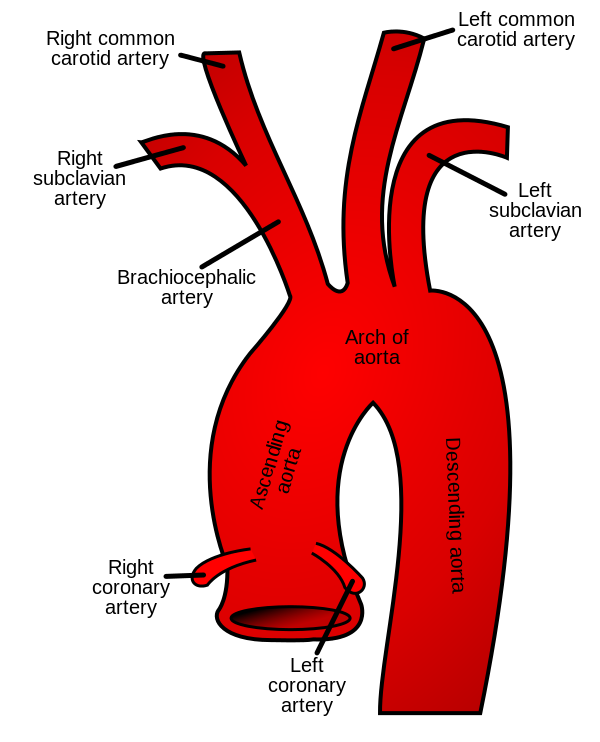
Check out that diagram above. See the brachiocephalic artery and the left carotid artery? These vessels carry blood up to your brain. The brachiocephalic artery supplies your right side of the brain with oxygen (and also feeds the right arm) and the left carotid artery supplies the left side of the brain with blood.

Understanding this blood flow will be important when we eventually talk about strokes (the sudden death and damage to brain cells due to lack of oxygen either from a rupture of vessels or a clot in the brain vessels) and how they can form.
And that’s the most important parts of blood flow in a nutshell.
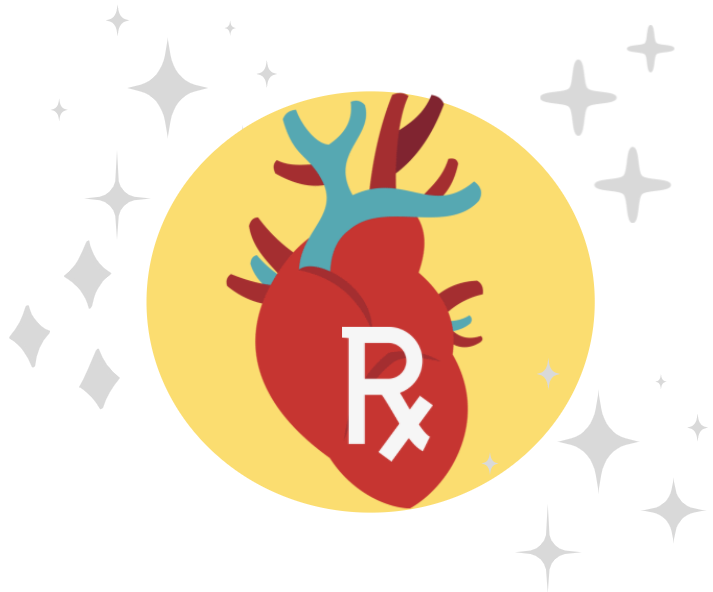
7 thoughts on “Coronary Anatomy – An Overview”